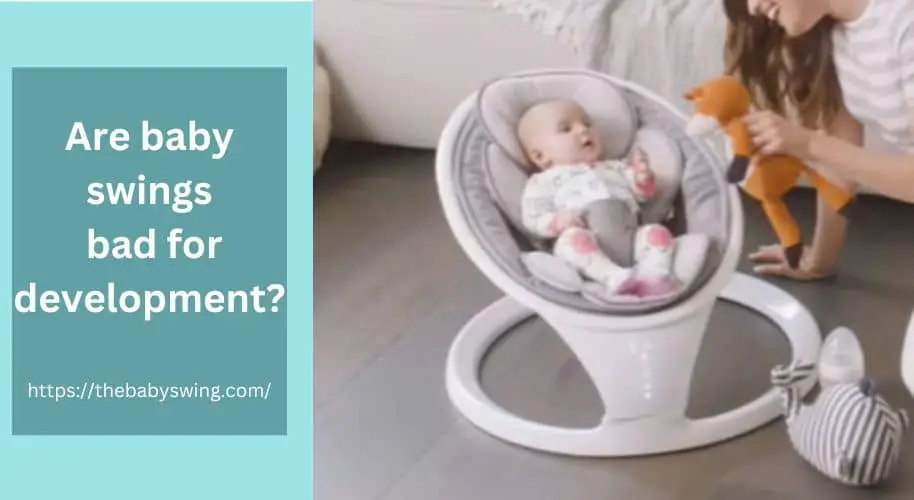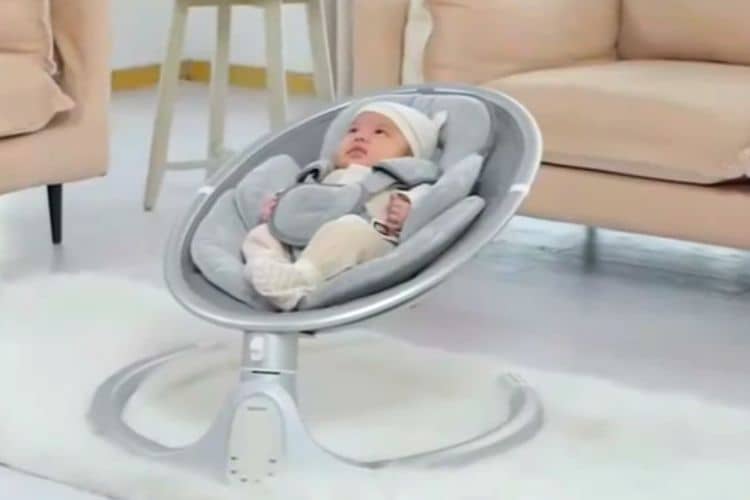Last Updated on July 19, 2023
When it comes to baby swings, parents often have questions about their safety and potential impact on development. While baby swings can be a great way to soothe and entertain your little one, it’s essential to understand their potential risks.
Baby swings are not recommended for infants under four months old because their neck muscles are not yet strong enough to support their heads.
Additionally, babies should never be left unattended in a swing as they can easily slip out or become entangled in the straps.
You should also note that using a swing too much can interfere with your baby’s natural development of motor skills such as rolling over, crawling and walking.
In this article, we’ll explore the potential risks associated with baby swings and provide strategies to ensure your little one remains safe and comfortable while using them. So, keep reading!

Are baby swings bad for development?
As mentioned above, baby swings are generally considered safe, but there are some concerns about their use.
The American Academy of Pediatrics (AAP) recommends that babies should always sleep in a crib or bassinet and not in a swing. This is because swings can cause an increased risk of sudden infant death syndrome (SIDS).
Additionally, if used for too long, baby swings can cause developmental delays due to a lack of movement and stimulation.
Parents must follow the manufacturer’s instructions when using a baby swing.
“Swings can be great tools to help soothe a baby, but they should not replace regular interaction and physical activity,” says Robert Blum, a pediatrician at Southfield Pediatric Physicians.
“If a baby is spending too much time in a swing, it can lead to delays in reaching motor milestones, such as rolling over and sitting up,” he added.
The AAP also recommends that you limit your baby’s time in the swing to no more than 30 minutes at a time and never leave your baby unattended while they are in the swing.
Ensure the seat is securely fastened and the straps fit snugly around your baby.
So, it is best to use a baby swing sparingly and only when necessary. If you do choose to use one, make sure you take all safety precautions into consideration.
Also read: How to wean off baby swing
Is swing bad for baby brain?
Are baby swings bad for your baby’s brain? The answer is a resounding NO! Baby swings don’t cause Shaken Baby Syndrome or brain damage, as their motion is simply not enough to do so.
In fact, spending time in swings can help babies develop their sense of vestibular movement and provide excellent stimulation to their bodies and brains.
Electric baby swings are safe until parents observe any signs of discomfort from the baby.
It’s important to communicate with your child about the proper use of the swing and ensure that they don’t disrupt it too much.
Ultimately, there is no evidence that baby swings cause brain damage or shaken baby syndrome so that you can use a baby swing without worry.
Is it bad for babies spine?
While it is generally recommended that babies should not sleep in a swing due to the risk of sudden infant death syndrome (SIDS), there are other potential risks associated with prolonged use of a baby swing.
The American Academy of Pediatrics (AAP) advises against placing infants in weight-bearing positions with baby bouncers or walkers, as this can introduce micro-repetitive stress to their little spines, which may affect their development.
Prolonged use of a baby swing can also lead to poor posture and scoliosis. Additionally, when a baby falls asleep in a swing, their head can flop forward, potentially obstructing their airway.
You should also be aware of these potential risks and take steps to ensure your baby’s safety while using a swing. Make sure you monitor your baby while they are in the swing and provide them with plenty of time on their back or tummy when they are awake and supervised.
“You should understand that a baby’s spine is very delicate and needs to be taken care of properly.” says Dr. Robert. “When a baby is born, their spine is in a C-shape until they develop head control and the ability to crawl.”
“Lying on the back stretches the C-shape of the spine, which helps them develop strong neck muscles and encourages healthy spinal development, he added.
Additionally, forcing babies into sitting positions before they are ready can cause brain and spine injuries due to their undeveloped muscles and ligaments.
Overall, it is best to limit the amount of time your baby spends in a swing and ensure that they get plenty of time on their back or tummy when awake and supervised.
Also read: How do I help my congested baby sleep better at night
What are the potential risks associated with baby swings?

There are several risks associated with baby swings. These are:
1. Strangulation hazard:
Long cords that are present on some baby swings can pose a risk of strangulation, especially if the child is able to reach it or get their arms or legs caught in the cord.
2. Entrapment hazard:
Many baby swings have slots and small openings where babies can become entangled or trapped while swinging. This can cause serious injury or even death in some cases.
3. Suffocation hazard:
Unsupported infants may be at risk for suffocation due to soft bedding materials used in some types of baby swings. Make sure to use only firm mattresses that fit snugly into the swing’s frame when placing your infant in a swing for sleep time.
4. Tip over hazard:
If the baby swing is not properly secured according to manufacturer instructions, it may tip over while in use and cause injury to your child.
5. Falling out hazard:
Baby swings that do not have a proper restraint system can pose a risk of falling out for infants and toddlers, resulting in serious injuries. Always make sure your baby’s device has a good five-point harness or other safety straps before using it.
6. Fire hazard:
Some older models of baby swings are known to be equipped with faulty electric cords which can potentially cause a fire if left unchecked. Inspect the electrical components on any used swing you purchase for signs of wear or damage before using them for your infant or toddler.
7. Toxic chemicals:
Some baby swings contain toxic chemicals in their plastics and fabrics which can be harmful to your infant’s health. Look for swings made with organic materials and check the manufacturer’s website for information on chemical safety before purchasing a swing for your child.
8. Accidental injury:
There is always a risk of accidental injury when using any type of baby equipment, including swings. Always supervise your child closely while they are using the swing to minimize this risk as much as possible.
9. Overuse hazard:
Your baby should not use a swing continuously for more than 30 minutes at any one time, as this can lead to over-stimulation or developmental delays in some infants and toddlers. Always take regular breaks in between uses.
Is it bad for baby to be in swing too long?
Yes, as mentioned above, you must be aware of the potential risks associated with leaving your baby in a swing for too long.
Most experts recommend limiting your baby’s time in a motorized swing to an hour or less a day and even less for newborns.
Prolonged use of a baby swing can lead to physical issues such as flat head syndrome, as well as developmental delays due to lack of stimulation.
If you do choose to use a baby swing, you should keep an eye on your little one and make sure they don’t stay in the swing for too long. It’s also best not to let them sleep in the swing, as this can be hazardous and put them at risk of injury.
Is a swing necessary for a baby?
While swings can be helpful in soothing babies and providing parents with a break, they are not essential for every family.
Swings provide babies with a motion similar to what they experienced in the womb. The rocking and swinging motion can help calm down fussy infants when parents are too tired to rock them themselves.
However, it is important to use swings according to manufacturer instructions for safety reasons. Additionally, swings should never be placed on an elevated surface like a table or countertop; they must always be placed flat on the floor.
Bouncers and rockers are other options for soothing babies and providing parents with some much-needed rest.
Bouncers tend to provide more of a bouncing motion than swings, while rockers usually have a reclined seat so babies can sit up comfortably while rocking back and forth.
Ultimately, whether or not you choose to purchase a swing or another type of baby gear is up to you as the parent. Consider your budget, lifestyle, and needs before making any decisions about which items will work best for your family.
What are AAP Safe Swing Use Guidelines?
When using a baby swing, there are several important guidelines to follow to ensure the safety of your baby. Here are some key points to consider:
- Always read the manufacturer’s instructions for the weight and height limits of the swing before placing your baby in it.
- Avoid elevated surfaces when placing the swing, as this can increase the risk of tip-overs and falls.
- Make sure that all straps and buckles are securely fastened and adjusted properly for your baby’s size.
- Never leave your baby unattended while they are in the swing, even if they seem content and comfortable.
- Limit swinging time to no more than 30 minutes at a time, as prolonged use can cause discomfort or fatigue in babies.
- Make sure that the swing is placed on a flat surface with enough space around it for proper ventilation and airflow.
- Check all parts of the swing regularly for signs of wear or damage, such as loose screws or frayed fabric, and replace any damaged parts immediately to avoid accidents or injuries.
Wrapping Up
Thanks for reading this guide on baby swings and their impact on development. As you can see, baby swings can be a great way to soothe your little one, as long as they are used sparingly and with all safety precautions in mind.
Remember to always follow the manufacturer’s instructions, never leave your baby unattended in the swing, and limit their time in it to no more than 30 minutes at a time. Doing this will help ensure your baby is safe and comfortable while using their swing.
Please share this article with others who may find it useful. Thanks for reading once again!
Sources:
- https://www.cpsc.gov/Business–Manufacturing/Business-Education/Business-Guidance/Infant-Swings
- https://www.mom365.com/baby-product-safety/baby-swing-safety
- https://www.federalregister.gov/documents/2022/09/20/2022-20246/safety-standard-for-infant-swings
- https://www.aap.org/en/news-room/news-releases/aap/2022/american-academy-of-pediatrics-updates-safe-sleep-recommendations-back-is-best/
Sharing Is Caring!

Dr. Leah Alexander is a board-certified general pediatrician who has been in practice for over 20 years. She began working as a pediatrician at Elizabeth Pediatric Group of New Jersey in 2000. Since 2005, she has been working as an independently contracted pediatrician with Medical Doctors Associates at Pediatricare Associates of New Jersey. Read more
